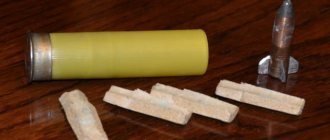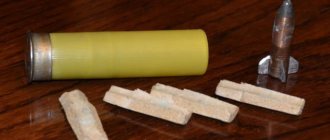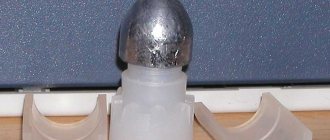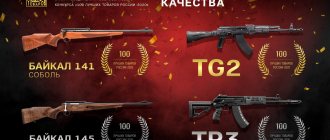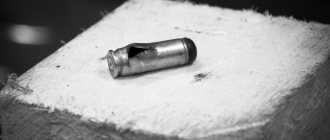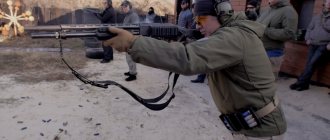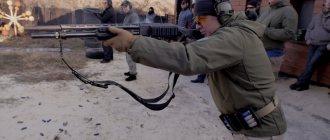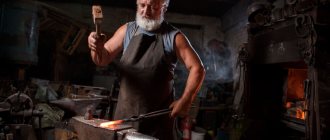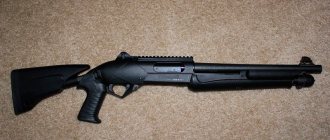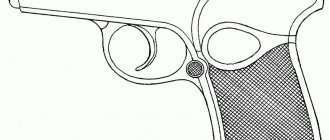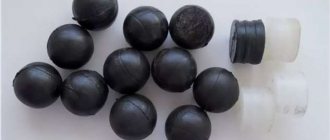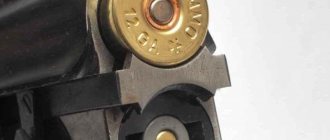Lead in the rifling
Properly cast and machined lead rifle bullets look beautiful.
Photo: Mikhail Semina Self-loading cartridges has two aspects.
The first is to obtain the most accurate and constant characteristics of ammunition, while its cost is unimportant.
It's about getting the most accurate cartridge possible for your rifle.
For these purposes, almost everything is on sale today.
This is explained simply: the more expensive the product, the easier it is to make a profit from it, so expensive bullets, cartridges and equipment are brought to us by hook or by crook.
The second option is to get the most inexpensive cartridge possible. Here you can sacrifice some of the quality in order to reduce the cost of the final product.
Such cartridges are needed for training, recreational shooting, and for developing skills in handling weapons. It is extremely important that the cartridge is cheaper than those that can be purchased in the store.
| The shape of lead bullets can be very diverse. Photo: ANDREY CHUGIN |
For rare calibers this is not a problem, for common ones, like 7.62x39 or 9x19, the price of which is eight to ten rubles, it is not easy, but, as practice has shown, when using a spent cartridge case and a lead bullet, it is quite possible.
Thus, a 9x19 cartridge of acceptable quality can be obtained for three to three and a half rubles, which will significantly reduce the cost of a trip to the shooting range.
WHY LEAD?
Firstly, correctly cast and processed lead bullets for rifled weapons look beautiful, and in the case of revolver cartridges and calibers, they also look authentic, but this is not the main thing. Secondly, lead is a material that can be found literally under your feet.
Where to get lead: from old batteries, old cables, or buy it in ingots - we will not dwell on this, it is absolutely clear that waste lead costs much less than purchased lead, but we must take into account that before using it you will have to work, clean it and melt it down.
Thirdly, this is a tribute to tradition: if you remember history, it all began with lead bullets. But the main thing, of course, is that the production of lead bullets is relatively simple and, as a result, inexpensive. That's what you need to get inexpensive ammunition.
Lead has both positive properties (it pours and forms easily, fits well into rifling, and in addition, it forgives small deviations from dimensions and weights), and negative ones: it heavily contaminates the barrel and is quite soft (for example, when dropped cartridges, a bullet easily gets dents ).
I will tell you below how to deal with the negative characteristics of lead.
EQUIPMENT
What do the boys need to melt lead to make sinkers? A fire, a tin can, a spoon and a nail - that's all the equipment. Unfortunately, producing lead bullets is a little more complicated and requires completely different equipment. And above all, the crucible.
They come in different sizes and designs. The choice of device is rather a matter of taste; Of course, it’s better to take more power, but the capacity needs to be selected for specific tasks.
Approximately determine what batches of bullets will be, and, based on this, calculate the capacity of the crucible. From personal experience, I can recommend the “tap” option, when lead can be poured directly from the crucible by opening a special hole at the bottom.
Practice has shown that this is the most convenient option: no special spoon is needed, and all the slag formed during melting remains on top, floats on the lead and does not interfere with the casting.
| Shooting with lead bullets allows you to reduce the cost of the process and gain more practice. Photo: ANTON ZHURAVKOVA |
The LII company makes inexpensive and easy-to-use crucibles (mine, for example, has been working for a couple of years without problems). Just remember to remove unused lead and slag after melting, and everything will be fine. A spoon in such a crucible will only be needed to remove the slag.
The main equipment for casting bullets - bullet machines - can be single- or multi-bullet. It seemed to me (from practice) that six-seaters are quite convenient to work with.
The diameter of lead bullets is slightly larger than jacket bullets, this is taken into account in the bullets, so if you take a .308 caliber bullet, the bullet itself will be slightly larger. The design of the bullet gun should be such that it can be easily heated, the injection channels can be cut off and opened.
For large batches, it is convenient to have two bullets or cast two calibers at once, since it takes some time for the lead to solidify, during which time the equipment is idle.
| photo: Semina Mikhail |
All kinds of calibrating and calibrating devices are convenient, but if we are talking about an inexpensive cartridge, it is unwise to spend money on them.
To equip cartridges with lead bullets, no additional equipment (compared to conventional jacketed bullets) is required.
PREPARING LEAD AND CASTING BULLETS
If the lead is from recycled materials, it must be melted down. This is necessary, as you will understand when you clean the crucible from slag after melting.
Anything can be found in lead from a landfill: metal, sand, and the like. It is necessary to melt at the maximum temperature and pour the material into small ingots, at least into the same spoon. In this form it is convenient to store it and select the required batch by weight for melting bullets.
| A good bullet machine allows you to cast up to 200 bullets per hour. Photo by the author. |
You can make bullets from pure lead obtained from a cable or battery, but they come out soft, heavily lead the barrel, despite the grease, and stain your hands. To increase hardness, you need to add a more refractory alloy into it.
It can be different metals, but I prefer antimony. It’s not easy to buy, but you don’t need a lot. I add about 3% antimony to my bullets, and the bullets do not break off the rifling, do not stain my hands, and look shiny and attractive.
Practice has shown that if the antimony content is more than 5%, the alloy becomes brittle. If you check the bullets manually, then a bullet cast from such an alloy does not “float” under the blow of a hammer, but cracks. Well, using antimony in large quantities is simply expensive.
Antimony can be put into the crucible immediately or thrown into already molten lead.
The process of melting and casting bullets is simple and interesting in its own way. We load lead into the crucible, melt it, add antimony, and heat the resulting alloy. Before casting, be sure to warm up the bullet.
If this is not done, the bullets will develop shells or ridges, and such bullets are best melted down.
On the Internet you can read recommendations to lubricate the bullet or sprinkle it with talcum powder, they say this reduces the likelihood of getting shells and hot flashes. Maybe. But when the bullet and lead are heated, there are no problems.
| Bulletley allows you to feel independent from external suppliers. Photo: ANTON ZHURAVKOVA |
But what is really necessary after the casting is completed is to wash the bullet with Fairy and lubricate it with gun oil.
So, we heat the bullet by simply placing it on the crucible, pour in lead, wait a little until it hardens, cut off the casting channels, open the bullet and evaluate the quality of the bullets; if they are normal, we continue to work; if not, it means that the bullet or the lead itself was not heated enough.
If you pour bullets for a long time or constantly, then you do not need to heat the bullet gun; if there is a break in the process, then we simply put the bullet on the crucible, after the process is completed, we pour the remaining lead into “spoons” and leave the crucible to cool, after which we clean it of slag.
OSALKA
There are special mechanisms and compositions for precipitating bullets; it makes sense to talk about them when receiving an expensive cartridge; for a bulk cartridge, everything should be inexpensive. So, we make the osalka ourselves.
To do this, we take 50% paraffin and 50% machine oil (in the trashiest survival option - “used” candles and waste oil filtered through cheesecloth). In a water bath, heat the paraffin until liquid and pour the oil into it. Stir the resulting mixture - it is liquid and mixes easily.
| Photo: SHUTTERSTOCK |
To settle the bullets, we proceed as follows: we place the bullets in the pan with a small distance between them and carefully, so as not to knock them over, pour the solution. It should cover the bullets above the sediment grooves.
After hardening, carefully squeeze out the bullets. We squeeze out, and do not break, the sludge tile. If you break it, there will be nothing left in the grooves; if you squeeze it out, the grooves will be filled with sediment.
The slurry will not only help reduce lead in the barrel, but will also simplify the loading of cartridges. Actually, the bullets are ready, you can load the cartridges.
EQUIPMENT OF CARTRIDGES
In general, there is no difference when equipping cartridges with lead bullets and shell bullets. You just need to pay attention to the fact that it is imperative to widen the case neck and seat the bullet in the case deeper than the sediment grooves.
The first feature will allow you to avoid jamming the cartridge case muzzle, the second will preserve residue on the bullet, which will have a positive effect on shooting results and will simplify subsequent cleaning. Some recommend lubricating the bullet itself with wax.
| Photo: SHUTTERSTOCK |
In my opinion, this gives nothing but dirt on your hands and inside the weapon magazine. When loading cartridges with lead bullets, the question of gas checks—small brass pans—necessarily arises. They are placed on the bottom of the bullet and do not allow it to break off the rifling.
Yes, it really works, but their cost is such that, in my opinion, it kills the very idea of a cheap cartridge.
A LITTLE CONCLUSION
In this article I shared my personal experience of making lead bullets for an inexpensive cartridge. Initially, the bullets were made without additives, but this option led to the rifling breaking off in .308 and 8x57 calibers and to severe leading of the barrel.
I also tried to equip without preloading, but such savings resulted in jammed cartridge cases and severe lead-lining of the barrel. The described option allows you to obtain the most convenient bullets and cartridges for use at the lowest price.
Sergey Smolnin December 28, 2022 at 10:42 am
Crucibles for casting bullets
The casting crucible is a special electrical unit that is necessary to ensure the melting of lead, which is the material used for making bullets. A large selection of such products is produced by Lee. It supplies the market with small budget models, the design of which does not provide an outlet for discharging molten lead, and analogues for casting in fairly large volumes, and professional equipment. We offer models with a volume of 4.5 and 9 liters.
Heating up the Lee crucible takes about 20-30 minutes (depending on the volume of the lead melting tank). It is recommended to fill the device with metal at least two-thirds to ensure an optimal level of pressure of the material at the exit of the crucible, which plays a role in the quality level of the bullet.
Important!!! You need to carefully approach the issue of heating lead. On the one hand, if the metal is very overheated, its fluidity will be higher, but there is a risk of cavities forming in the product as a result of boiling. This will inevitably lead to such negative consequences as a displacement of the bullet’s center of gravity.
On the other hand, a slight heating of lead will result in a decrease in the fluidity of the metal and an increase in the likelihood of air getting into the bullet and the formation of cavities in it.
Bullet guns - devices for casting bullets
Visually, bullets resemble ticks. They are equipped with two handles and movable metal components, from which a split-type casting mold is actually formed. Before making bullets, the ends of the bullet are closed, resulting in reservoirs for pouring molten lead (done from a special connector or using a casting spoon). After the metal hardens, the working part of the tool is placed in cold water and then opened.
As the temperature drops, the lead blanks naturally shrink, so that the bullets can be easily removed in the future. The number of ready-made components for cartridges may vary. We have models of Lee fixtures for making two or six products at the same time. They are designed to produce bullets of a certain caliber, weight and shape.
Spare parts for bullet casting fixtures
In some cases, people engaged in casting bullets on their own need to purchase not devices for this process, but their individual components. Among such products, our catalog includes tongs for bullets and heating elements for crucibles.
The availability of components and spare parts allows customers to achieve significant savings, because in the event of a breakdown of any equipment or tool, they will not have to buy a new product. It will be enough to place an order for its component, which will be several times cheaper.
To receive consulting support on bullet casting issues, you can contact the managers of our online store of military antiques “Derzhava”. They are competent to answer questions about the specifics of using each of the presented devices, as well as give general recommendations on casting bullets at home.
